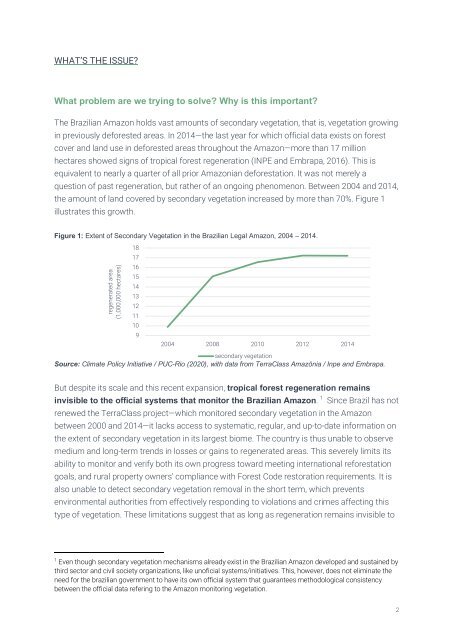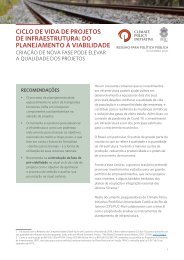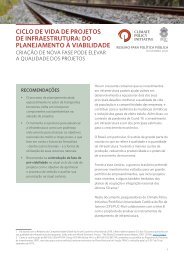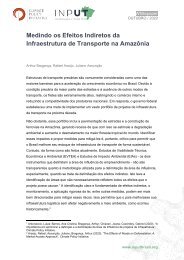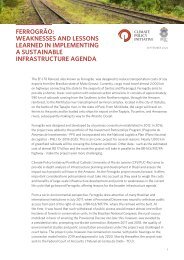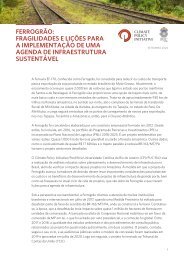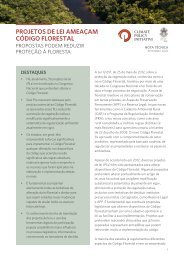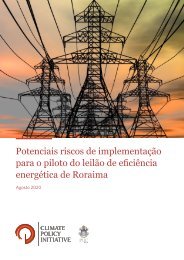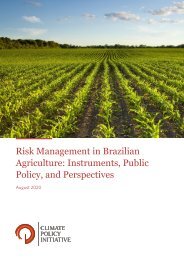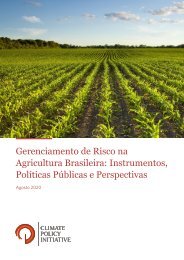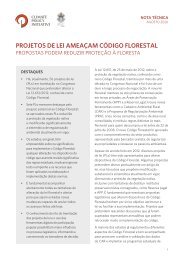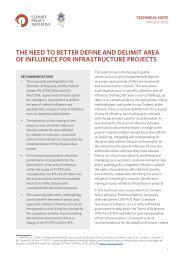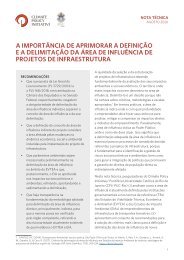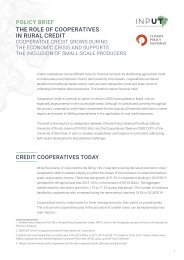Brazil Needs to Monitor its Tropical Regeneration
Create successful ePaper yourself
Turn your PDF publications into a flip-book with our unique Google optimized e-Paper software.
WHAT’S THE ISSUE?<br />
What problem are we trying <strong>to</strong> solve? Why is this important?<br />
The <strong>Brazil</strong>ian Amazon holds vast amounts of secondary vegetation, that is, vegetation growing<br />
in previously deforested areas. In 2014—the last year for which official data exists on forest<br />
cover and land use in deforested areas throughout the Amazon—more than 17 million<br />
hectares showed signs of tropical forest regeneration (INPE and Embrapa, 2016). This is<br />
equivalent <strong>to</strong> nearly a quarter of all prior Amazonian deforestation. It was not merely a<br />
question of past regeneration, but rather of an ongoing phenomenon. Between 2004 and 2014,<br />
the amount of land covered by secondary vegetation increased by more than 70%. Figure 1<br />
illustrates this growth.<br />
Figure 1: Extent of Secondary Vegetation in the <strong>Brazil</strong>ian Legal Amazon, 2004 – 2014.<br />
regenerated area<br />
(1,000,000 hectares)<br />
18<br />
17<br />
16<br />
15<br />
14<br />
13<br />
12<br />
11<br />
10<br />
9<br />
2004 2008 2010 2012 2014<br />
secondary vegetation<br />
Source: Climate Policy Initiative / PUC-Rio (2020), with data from TerraClass Amazônia / Inpe and Embrapa.<br />
But despite <strong>its</strong> scale and this recent expansion, tropical forest regeneration remains<br />
invisible <strong>to</strong> the official systems that moni<strong>to</strong>r the <strong>Brazil</strong>ian Amazon. 1 Since <strong>Brazil</strong> has not<br />
renewed the TerraClass project—which moni<strong>to</strong>red secondary vegetation in the Amazon<br />
between 2000 and 2014—it lacks access <strong>to</strong> systematic, regular, and up-<strong>to</strong>-date information on<br />
the extent of secondary vegetation in <strong>its</strong> largest biome. The country is thus unable <strong>to</strong> observe<br />
medium and long-term trends in losses or gains <strong>to</strong> regenerated areas. This severely lim<strong>its</strong> <strong>its</strong><br />
ability <strong>to</strong> moni<strong>to</strong>r and verify both <strong>its</strong> own progress <strong>to</strong>ward meeting international reforestation<br />
goals, and rural property owners’ compliance with Forest Code res<strong>to</strong>ration requirements. It is<br />
also unable <strong>to</strong> detect secondary vegetation removal in the short term, which prevents<br />
environmental authorities from effectively responding <strong>to</strong> violations and crimes affecting this<br />
type of vegetation. These limitations suggest that as long as regeneration remains invisible <strong>to</strong><br />
1<br />
Even though secondary vegetation mechanisms already exist in the <strong>Brazil</strong>ian Amazon developed and sustained by<br />
third sec<strong>to</strong>r and civil society organizations, like unoficial systems/initiatives. This, however, does not eliminate the<br />
need for the brazilian government <strong>to</strong> have <strong>its</strong> own official system that guarantees methodological consistency<br />
between the official data refering <strong>to</strong> the Amazon moni<strong>to</strong>ring vegetation.<br />
2


